The History of New Zealand(英语国家概况新西兰)
- 格式:pptx
- 大小:4.11 MB
- 文档页数:16
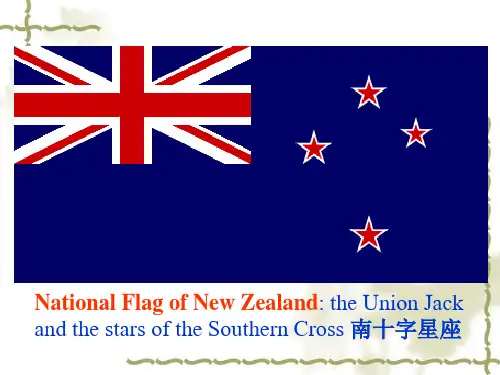
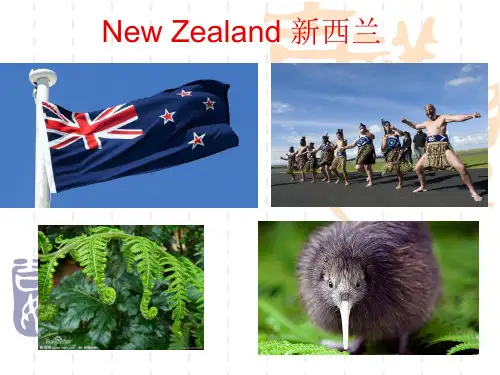
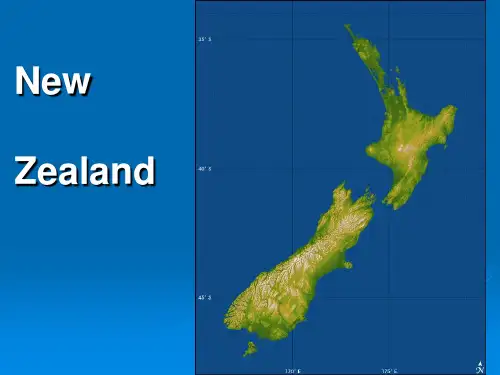
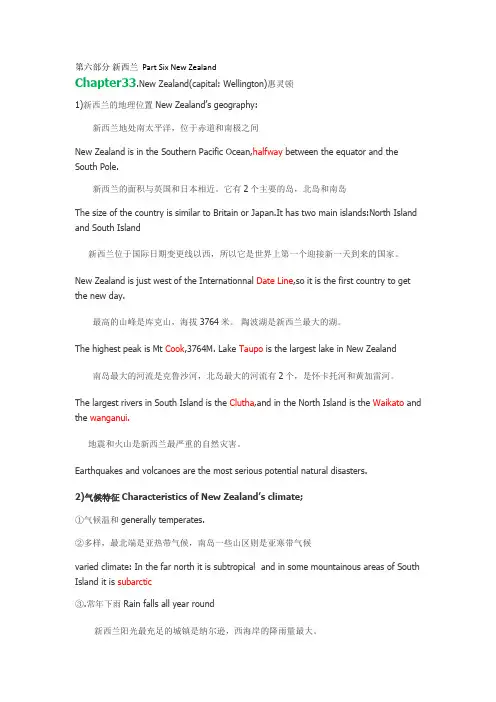
第六部分新西兰 Part Six New ZealandChapter33.New Zealand(capital: Wellington)惠灵顿1)新西兰的地理位置New Zealand’s geography:新西兰地处南太平洋,位于赤道和南极之间New Zealand is in the Southern Pacific Ocean,halfway between the equator and the South Pole.新西兰的面积与英国和日本相近。
它有2个主要的岛,北岛和南岛The size of the country is similar to Britain or Japan.It has two main islands:North Island and South Island新西兰位于国际日期变更线以西,所以它是世界上第一个迎接新一天到来的国家。
New Zealand is just west of the Internationnal Date Line,so it is the first country to get the new day.最高的山峰是库克山,海拔3764米。
陶波湖是新西兰最大的湖。
The highest peak is Mt Cook,3764M. Lake Taupo is the largest lake in New Zealand 南岛最大的河流是克鲁沙河,北岛最大的河流有2个,是怀卡托河和黄加雷河。
The largest rivers in South Island is the Clutha,and in the North Island is the Waikato and the wanganui.地震和火山是新西兰最严重的自然灾害。
Earthquakes and volcanoes are the most serious potential natural disasters.2)气候特征Characteristics of New Zealand’s climate;①气候温和generally temperates.②多样,最北端是亚热带气候,南岛一些山区则是亚寒带气候varied climate: In the far north it is subtropical and in some mountainous areas of South Island it is subarctic③.常年下雨Rain falls all year round新西兰阳光最充足的城镇是纳尔逊,西海岸的降雨量最大。

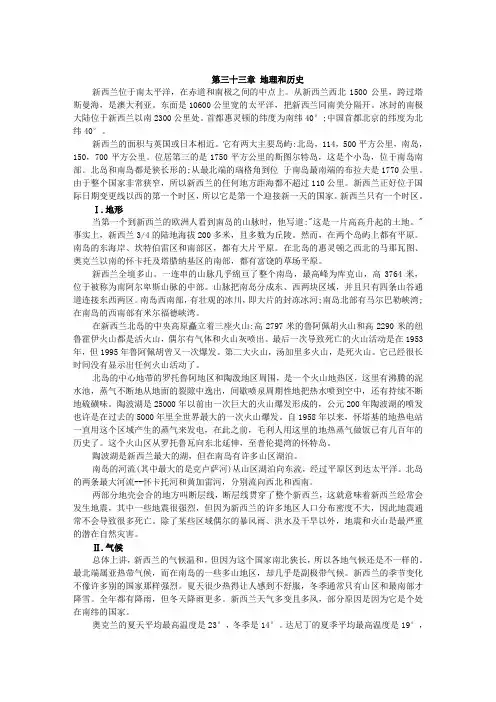
第三十三章地理和历史新西兰位于南太平洋,在赤道和南极之间的中点上。
从新西兰西北1500公里,跨过塔斯曼海,是澳大利亚。
东面是10600公里宽的太平洋,把新西兰同南美分隔开。
冰封的南极大陆位于新西兰以南2300公里处。
首都惠灵顿的纬度为南纬40°;中国首都北京的纬度为北纬40°。
新西兰的面积与英国或日本相近。
它有两大主要岛屿:北岛,114,500平方公里,南岛,150,700平方公里。
位居第三的是1750平方公里的斯图尔特岛,这是个小岛,位于南岛南部。
北岛和南岛都是狭长形的;从最北端的瑞格角到位于南岛最南端的布拉夫是1770公里。
由于整个国家非常狭窄,所以新西兰的任何地方距海都不超过110公里。
新西兰正好位于国际日期变更线以西的第一个时区,所以它是第一个迎接新一天的国家。
新西兰只有一个时区。
Ⅰ.地形当第一个到新西兰的欧洲人看到南岛的山脉时,他写道:"这是一片高高升起的土地。
"事实上,新西兰3/4的陆地海拔200多米,且多数为丘陵。
然而,在两个岛屿上都有平原。
南岛的东海岸、坎特伯雷区和南部区,都有大片平原。
在北岛的惠灵顿之西北的马那瓦图、奥克兰以南的怀卡托及塔腊纳基区的南部,都有富饶的草场平原。
新西兰全境多山。
一连串的山脉几乎绵亘了整个南岛,最高峰为库克山,高3764米,位于被称为南阿尔卑斯山脉的中部。
山脉把南岛分成东、西两块区域,并且只有四条山谷通道连接东西两区。
南岛西南部,有壮观的冰川,即大片的封冻冰河;南岛北部有马尔巴勒峡湾;在南岛的西南部有米尔福德峡湾。
在新西兰北岛的中央高原矗立着三座火山:高2797米的鲁阿佩胡火山和高2290米的纽鲁霍伊火山都是活火山,偶尔有气体和火山灰喷出。
最后一次导致死亡的火山活动是在1953年,但1995年鲁阿佩胡曾又一次爆发。
第二大火山,汤加里多火山,是死火山。
它已经很长时间没有显示出任何火山活动了。
北岛的中心地带的罗托鲁阿地区和陶泼地区周围,是一个火山地热区,这里有沸腾的泥水池,蒸气不断地从地面的裂隙中逸出,间歇喷泉周期性地把热水喷到空中,还有持续不断地硫磺味。

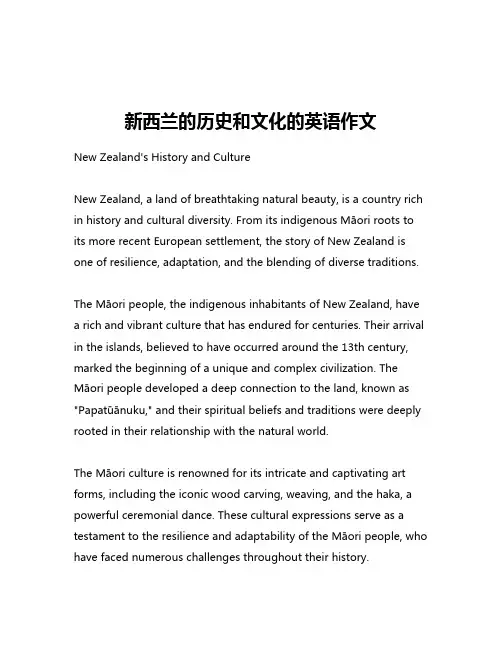
新西兰的历史和文化的英语作文New Zealand's History and CultureNew Zealand, a land of breathtaking natural beauty, is a country rich in history and cultural diversity. From its indigenous Māori roots to its more recent European settlement, the story of New Zealand is one of resilience, adaptation, and the blending of diverse traditions.The Māori people, the indigenous inhabitants of New Zealand, have a rich and vibrant culture that has endured for centuries. Their arrival in the islands, believed to have occurred around the 13th century, marked the beginning of a unique and complex civilization. TheMāori people developed a deep connection to the land, known as "Papatūānuku," and their spiritual beliefs and traditions were deeply rooted in their relationship with the natural world.The Māori culture is renowned for its intricate and captivating art forms, including the iconic wood carving, weaving, and the haka, a powerful ceremonial dance. These cultural expressions serve as a testament to the resilience and adapt ability of the Māori people, who have faced numerous challenges throughout their history.One of the most significant events in New Zealand's history was the signing of the Treaty of Waitangi in 1840. This document, negotiated between the British Crown an d Māori chiefs, established the basis for the country's bicultural foundation. The treaty recognized the rights of the Māori people and their sovereignty, while also paving the way for British settlement and the eventual establishment of New Zealand as a dominion of the British Empire.The arrival of European settlers, particularly from Britain, marked a significant transformation in New Zealand's history. These settlers brought with them new technologies, agricultural practices, and architectural styles, which gradually blended with the existing Māori traditions. This process of cultural exchange and integration has continued to shape the unique identity of New Zealand.One of the hallmarks of New Zealand's cultural landscape is its vibrant and diverse ar ts scene. From the renowned Māori performing arts to the thriving contemporary art movement, the country has produced a wealth of talented artists, writers, and musicians who have gained international recognition. The country's natural beauty has also been a source of inspiration for many creative individuals, with the stunning landscapes and seascapes serving as a backdrop for their work.In addition to its rich cultural heritage, New Zealand is also knownfor its stunning natural environment. The country's diverse landscapes, ranging from rugged mountain ranges to pristine beaches and lush rainforests, have made it a popular destination for outdoor enthusiasts and nature lovers. The country's commitment to environmental conservation and sustainable practices has also played a significant role in preserving its natural wonders for future generations.The story of New Zealand's history and culture is one of resilience, adaptation, and the blending of diverse traditions. From the indigenous Māori people to t he more recent European settlers, the country has evolved into a unique and vibrant society that celebrates its diversity and its connection to the natural world. Whether exploring its rich cultural heritage, marveling at its stunning natural beauty, or engaging with its thriving arts scene, there is much to discover and appreciate in the land of the long white cloud.。
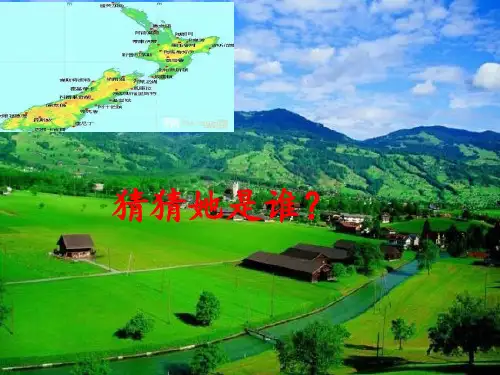
猜猜她是谁?地球上最后一块绿洲。
地球上最年轻的国家, 也是地球上最后一块被发现的主要大陆这就是上帝的后花园人间的最后一片净土101103A 张玉장옥1.历史简史2.概述3.饮食4.风土人情5.明星钟爱新西兰6.一起玩转新西兰3. 新西兰简史(Brief History of New Zealand)●殖民时期以前(before the Colonial Period):在欧洲人到来之前,毛利人(Maori)居住在新西兰。
3. 新西兰简史(Brief History of New Zealand)●殖民地时期(Colonial Period):1840年2月6日,英国与毛利人酋长签订《怀唐伊条约》(Treaty of Waitangi),并将其归入英帝国版图。
3. 新西兰简史(Brief History of New Zealand)●独立(Independence):1907年英国被迫同意新西兰独立,成为英联邦的自治领(Independent Dominion)。
1931年,英国正式颁布威斯敏斯特条例(Statute of Westminster)。
新西兰正式获得完全自主,成为英联邦(Commonwealth)的一员。
国旗新西兰国旗为长方形,长宽之比为2:1。
旗底为深蓝色,左上方为英国国旗,右边有四颗镶白边的红色五角星,四颗星排列均不对称。
新西兰是英联邦成员国,“米”字图案表明同英国的传统关系;四颗星表示南十字星座,表明该国位于南半球,同时还象征独立和希望。
国歌及首都•国歌(national anthem):•《天佑新西兰》(God Defend New Zealand)•首都(Capital):惠灵顿(Wellington )•国花:银蕨•国鸟:鹬鸵•国庆日(National Day)2月6日•官方语言(Official Language)英语,毛利语(Maori)宗教(Religion)基督新教天主教季节与气温春季为9-11月夏季为12-2月秋季为3-5月冬季为6-8月夏季日照时间是6:00-21:00,冬季日照时间是8:00-17:00。
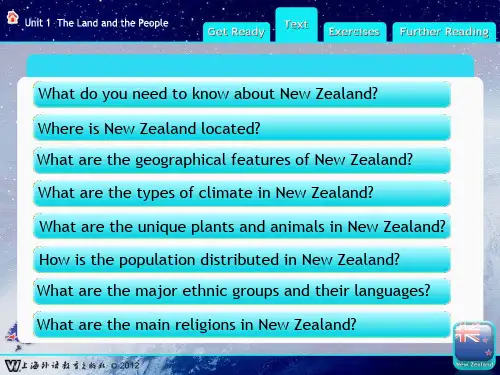
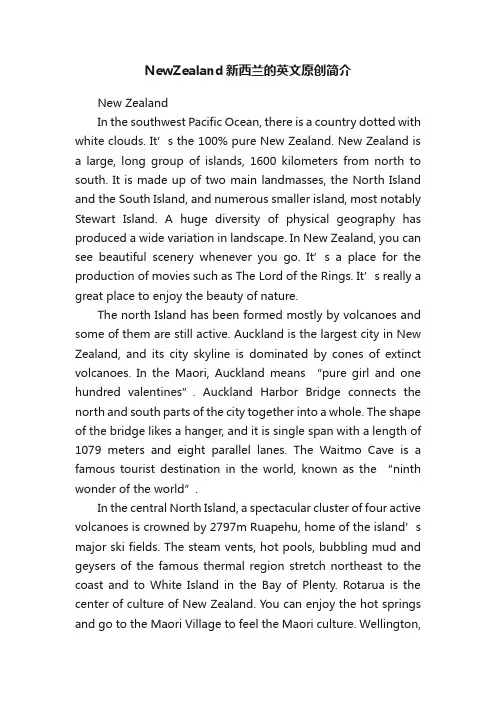
NewZealand新西兰的英文原创简介New ZealandIn the southwest Pacific Ocean, there is a country dotted with white clouds. It’s the 100% pure New Zealand. New Zealand is a large, long group of islands, 1600 kilometers from north to south. It is made up of two main landmasses, the North Island and the South Island, and numerous smaller island, most notably Stewart Island. A huge diversity of physical geography has produced a wide variation in landscape. In New Zealand, you can see beautiful scenery whenever you go. It’s a place for the production of mov ies such as The Lord of the Rings. It’s really a great place to enjoy the beauty of nature.The north Island has been formed mostly by volcanoes and some of them are still active. Auckland is the largest city in New Zealand, and its city skyline is dominated by cones of extinct volcanoes. In the Maori, Auckland means “pure girl and one hundred valentines”. Auckland Harbor Bridge connects the north and south parts of the city together into a whole. The shape of the bridge likes a hanger, and it is single span with a length of 1079 meters and eight parallel lanes. The Waitmo Cave is a famous tourist destination in the world, known as the “ninth wonder of the world”.In the central North Island, a spectacular cluster of four active volcanoes is crowned by 2797m Ruapehu, home of the island’s major ski fields. The steam vents, hot pools, bubbling mud and geysers of the famous thermal region stretch northeast to the coast and to White Island in the Bay of Plenty. Rotarua is the center of culture of New Zealand. You can enjoy the hot springs and go to the Maori Village to feel the Maori culture. Wellington,the capital of New Zealand, is situated at the southwestern tip of the North Island between Cook Strait and the Rimutaka Range. Wellington is the southernmost capital city and also the most remote capital city in the world. It is a famous tourist destination in the South Pacific and its café culture is prominent. The city has more cafés per capita than New York City. So if you are fond of coffee, don’t miss it.A massive mountain chain, the Southern Alps, runs almost the full length of the South Island. This is an area of outstanding scenic beauty, with the Marlborough Sounds in the north, many beautiful lakes and rivers, and Fiordland with its remote, deeply-cut inlets in the southwest.Queenstown, the most famous tourist attractions in the South Island, is surrounded by south of the Alps. Its nature beauty changes with the seasons, the lake gleams in the summer sun, and snow covers mountains above the township in winter. Nestled in beside the mysterious Lake Wakatipu, in the southern Lakes district of New Zealand, Queenstown is a cosmopolitan haven, offering a limitless adventure, southern wine and cuisine, and breathtaking alpine scenery. Along the Lake Wakatipu, there are many romantic café, when beacon lights reflected in the lake, people can’t help rising and dancing in a happy mood with the gently flowing music, and then you’ll find out that Queenstown can be romantic. Queenstown is a town with torrent, fjords, mountains and other adventures environment. It’s the birthplace of the bungee jumping. Enjoying the impact of the gravity acceleration in beautiful scenery absolutely makes you lead a person to endless aftertastes. Christchurch is in the South Island on th e east, also known as “garden city”, because of plenty of beautiful flowers in the city. Classical architecture ofRenaissance type has been a symbol of the city. You can overlook the city in a hot air balloon, and appreciate the beauty in a special way. And there is also a special festival, the Hot Balloon Festival, which is held in the end of March every year.Having been separated from other land for millions of years, the islands of New Zealand have their unique flora and fauna. A large number of native birds and plants, insects, spiders and snails,as well as all native earth worms, are found only in New Zealand. Kiwi is the national bird and it’s the only bird without wings. The word kiwi should be remembered for it is the name of the bird from which New Zealanders have adopted their name. In colloquial English, the Kiwi, capitalized, means a New Zealander. The tuatara is the most interesting, being the only surviving species of a reptile family which otherwise became extinct 100 million years ago.And when traveling in New Zealand, you should know some etiquette of meeting. New Zealanders always meet the guests by shaking hands in a social situation. When they meet a woman, they need to wait the woman reaches out her hand first. Maori use their nose to touch guest’s nose when they meet guests. It’s called “Hongi” and it’s the highest honor to the guests. New Zealanders are hospitable. They have a traditional of respecting elders. When you come here, Maoris use songs and dances to welcome visitors. They regard water as pure and holy things, so they sprinkle water to visitors. This is a symbol of blessing. And they don’t accept tips.The indigenous Maori name for New Zealand is Aotearoa, commonly translated as land of the long white cloud. Come to the pure world to find the peace of your mind.。
新西兰:历史与文化的交融Nestled in the southwestern Pacific Ocean, New Zealandis a land of diverse natural beauty and rich cultural heritage. Its history, though relatively short compared to other nations, is nonetheless fascinating, marked by migrations, explorations, and a unique blend of Maori and European cultures.The first inhabitants of New Zealand were the Maori,who arrived in canoes from Polynesia around the 13th century. They brought with them a rich culture, including a complex language, unique art forms, and a deep respect for nature. Their settlement of the land was marked by a harmonious coexistence with the environment, evident intheir architecture, farming techniques, and social structures.The arrival of European explorers in the 18th century marked a significant turning point in New Zealand's history. The British, in particular, were drawn to the region by its natural resources and strategic location. Over the courseof the 19th century, New Zealand became a British colony,and with this came a influx of European settlers and culture.This influx led to a融合 of Maori and European cultures, resulting in a unique New Zealand identity. The Maori language, arts, and traditions have been preserved and celebrated, while European influences have shaped the country's politics, economy, and society. This blend of cultures is evident in every aspect of New Zealand life, from its vibrant cities to its rural landscapes.In recent years, New Zealand has emerged as a global leader in environmental sustainability, reflecting its Maori roots and commitment to protecting its natural environment. The country has also become a popular destination for tourists, drawn by its scenic landscapes, adventure activities, and friendly people.In conclusion, New Zealand's history and culture are a testament to the power of migration and the beauty of cultural diversity. Its unique blend of Maori and European influences has created a rich and vibrant society that continues to thrive and evolve. As New Zealand moves forward, it remains committed to preserving its culturalheritage while embracing the opportunities of a globalized world.**新西兰:历史与文化的交织**坐落于西南太平洋的新西兰,是一个拥有多样自然美景和丰富文化遗产的国家。
New Zealand / AotearoaSymbolsFlag∙The Union flag is in the top cornero Shows loyalty to Britain∙Southern Crosso A constellation seen in the Southern hemisphereNational Anthem∙“God Save the Queen”∙“God Defend New Zealand”o Both in English and MaoriNational Symbol∙The Kiwi – a flightless birdThe Land and the PeopleLocated in the Pacific OceanNorth Island∙Auckland – the largest city∙Wellington – the capital city∙There are many volcanoes on the island∙There are four volcanic mountainso Mount Egmont – most famouso Mount Ruapehu – the highest mountaino Mount Ngauruhoe – most activeo Mount Tonngariro – smallest mountain∙Swift rivers∙Hot springs∙Craters∙Energyo Geothermalo Hydro-electricSouth Island∙The most impressive mountains∙Glacierso Form lakes and riversClimate∙Mild temperatures∙High rainfall∙Many hours of sunshine∙The mountains influence the weathero Western side is very weto Eastern side is very dryPlants and Animals∙Geographic isolation and weather has led to the evolution of unique species only found on New Zealand!∙Almost no native mammals∙An abundance of different birds∙ A diversity of marine life∙The Kiwi – the National Symbol of NZ∙Kakapo – worlds largest parrot∙Tuatara – only beak-headed reptile∙Hector’s dolphinso The world’s largest dolphinso Only found in New ZealandPeople∙Population – 4.24 million peopleo¾ live on the North Islando85.4% live in urban areaso80% are of mixed European descent▪English, Scottish, Irish, German, etc.∙Maorio Largest non-European group (15%)o Original inhabitants (around 1100)o Polynesian∙Official Languageso English and Maori∙No state religion (freedom of religion)o40% have no religious affiliation▪Number is growing∙Dominate religion is Christianityo In declineHistory and the PresentMaori∙Descendants from the first Polynesian settlers around 1000AD∙Named the land AotearoaEuropean∙Dutch explorer Abel Tasman was the first European to discover NZ in 1642∙British explorer Captain James Cook mapped the island in 1796∙Newcomers were called Pakeha by the Maori∙The Pakeha were missionaries, traders, whalers, and sealersTreaty of Waitangi∙Attempt to ease tensions between the Maori and the colonists∙Signed in 1840∙The Maori chiefs give the British Queen governance of the islands∙The Queen’s representatives promise Maori ownership of the ir land, forests and fisheries ∙And gave the Maori the rights of British citizens∙Waitangi Day, New Zealand’s national day1840∙Britain establish first settlement at Wellington∙Land wars break out∙British ignore the Treaty and take land from the Maori∙By 1890, Maori own less than 1/6of New ZealandThe growth of a nation∙New Zealand Constitution Acto Establishes an independent government in 1852o General assemblyo Legislative councilo Elected house of representatives∙New Zealand officially becomes a dominion in 1907Late 19th Century∙Economic growtho The discovery of goldo Economy based on agricultureo Overseas trade in wool, meat, and dairy∙Progressive reformso1st country to allow women to vote in 1983o1st country to provide a pension to elderly people in 1898Modernization∙Full independence from Britain in 1947∙Economy continues to be based on agriculture∙Electoral reforms in 1993∙Minority parties are given better representation in parliamentRecreation∙Sportso British sports like rugby, cricket, netballo Unique geography makes skiing, hiking, skydiving, swimming, and fishing popular.∙Spend time in summer homes called “bachs” or “cribs”Maoritanga∙Rich and varied traditions of the Maori people∙Based on cooperation, loyalty, pride, and respect∙Maori are the official host people of New Zealand。